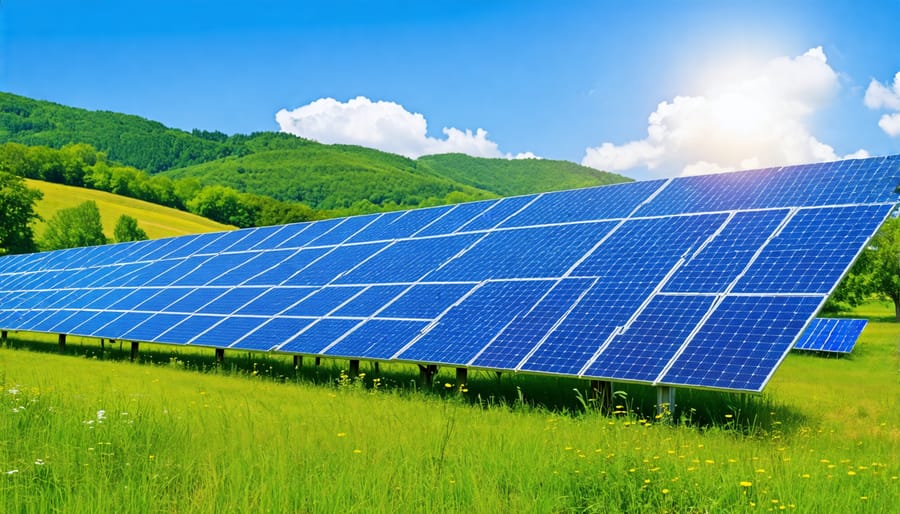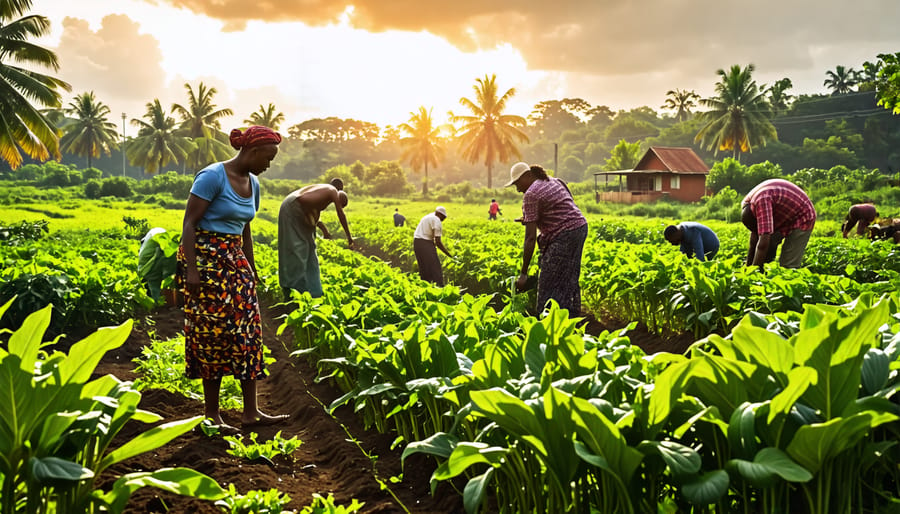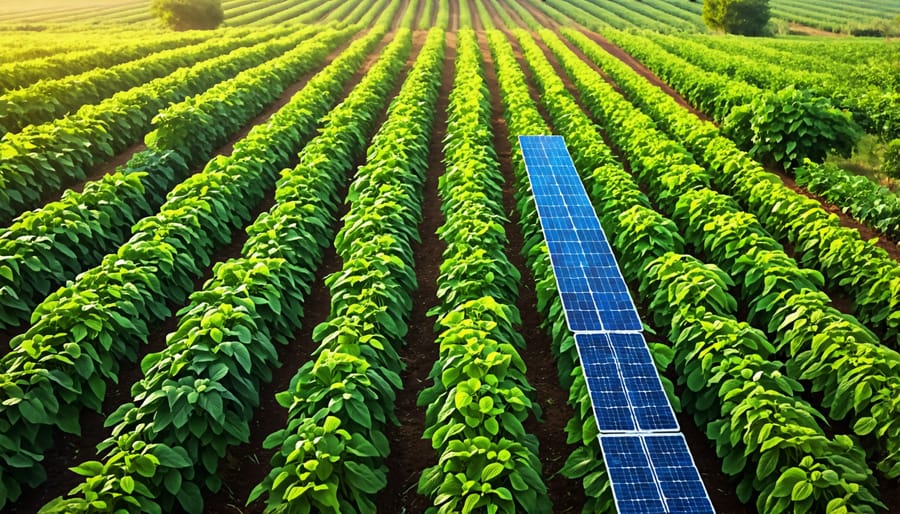Implement crop rotation to enhance soil fertility and reduce pest build-up. Utilize cover crops like clover or rye during off-season periods to prevent soil erosion and improve organic matter. Integrate agroforestry systems by planting trees alongside crops to boost biodiversity and sequester carbon. Incorporate precision agriculture technologies, such as satellite mapping and sensor-based soil analysis, to optimize resource use and improve crop yields sustainably.
The Science Behind Renewable Agriculture
Soil Health and Biodiversity
Maintaining soil health and biodiversity is vital for the success of renewable agriculture. Healthy soil teems with life, from microorganisms to larger fauna, which work synergistically to enrich soil fertility and optimize crop growth. “Soil is more than just dirt,” says Dr. Lisa Arthur, an ecologist who studies agricultural ecosystems. “It’s a living organism that forms the backbone of sustainable agriculture.” By preserving the biodiversity within soil, farmers can reduce reliance on chemical fertilizers and pesticides, subsequently minimizing ecological disruption.
Real-world applications of this principle can be seen in the implementation of crop rotations and cover cropping. These practices promote varied plant life, which in turn supports diverse microbial activity. For example, leguminous cover crops fix nitrogen, replenishing soil nutrients naturally. Additionally, diverse ecosystems within farms can bolster resilience to pests and disease, ensuring long-term productivity.
Ultimately, prioritizing soil health and biodiversity catalyzes healthier food systems, echoing nature’s own methods of sustainability and thriving, interconnected ecosystems.
Water Resource Management
Efficient water use in agriculture is essential for fostering sustainable food systems. Researchers like Dr. Emily Jones emphasize innovations such as precision irrigation and rainwater harvesting as vital tools in water stewardship. “Utilizing technology to match water supply with crop needs not only conserves resources but enhances yield quality,” Dr. Jones notes. In arid regions, farmers are increasingly adopting drip irrigation systems, which deliver water directly to plant roots, reducing evaporation losses significantly. Meanwhile, real-world applications are seen in California’s vineyards, where advanced soil moisture sensors optimize water delivery, ensuring every drop counts. These methods illustrate how balancing cutting-edge technology with traditional practices can produce sustainable outcomes. Moreover, integrated systems that capture and reuse runoff water further exemplify the potential of circular water use strategies in agriculture. As we face growing water scarcity challenges, these strategies hold promise, empowering communities to produce food sustainably while preserving essential water resources.
Innovative Practices in Sustainable Food Systems
Agroforestry and Polyculture
Agroforestry and polyculture represent pivotal strategies in renewable agriculture, aiming to enhance sustainability and crop resilience. Agroforestry integrates trees and shrubs into cropping systems, promoting biodiversity while improving soil health, water retention, and carbon sequestration. Polyculture, or the cultivation of multiple crops in a shared space, reduces pest and disease pressure naturally, minimizing the need for chemical interventions. Dr. Rebecca Golightly, a prominent researcher in sustainable farming practices, notes, “These systems mimic natural ecosystems, offering robust solutions to food security challenges.” In practice, farmers who adopt agroforestry techniques can see increased yields and economic resilience, as diverse crops provide multiple income streams. Polyculture further supports ecological balance, fostering habitats for beneficial insects and pollinators. The intertwining of such methods with innovations like vertical agrivoltaics highlights a future where agriculture is not only about producing food but also about nurturing the environment.

Integration of Renewable Energy
Integrating renewable energy into agricultural processes is crucial for reducing reliance on fossil fuels, which in turn helps mitigate climate change and enhances sustainability. Farms across the globe are increasingly embracing these technologies to power machinery, irrigate fields, and reduce carbon footprints. According to Dr. Emily Bell, a leading researcher in sustainable agriculture, “Utilizing renewable energy sources in farming not only cuts costs in the long run but also empowers farmers to contribute actively to a healthier planet.” Wind turbines, solar panels, and biomass generators are some of the effective sources of renewable energy that farmers are adopting to energize their operations. In California’s San Joaquin Valley, for instance, several farms have installed solar arrays to offset electricity needs during peak irrigation periods. The integration of these technologies ensures that agriculture not only meets present needs efficiently but is also poised to support future generations sustainably. By championing renewable energy, the agricultural sector is setting the stage for an environmentally conscious shift in food production.

Real-World Applications and Case Studies
Case Study: Large-Scale Implementation
Nestled in the heartland of Iowa, GreenField Farms stands as a testament to the power of renewable agriculture. This large-scale operation has seamlessly integrated practices that not only boost productivity but also enhance sustainability. The farm’s transition to renewable agricultural methods involved adopting solar-powered irrigation systems, which depleted their dependency on fossil fuels and slashed energy costs significantly. “Renewables have revolutionized our approach,” says Dr. Elena Ramirez, a leading researcher in sustainable agriculture, who has consulted with GreenField Farms. “By harnessing solar energy, we’re seeing both environmental and economic gains.”
GreenField has also incorporated crop rotation and cover cropping techniques, which work synergistically to improve soil health and reduce the need for chemical fertilizers. These practices, rooted in scientific research, aid in capturing carbon and boost biodiversity among local ecosystems. The results speak volumes: the farm has not only increased its yield but has also observed improved soil fertility and reduced greenhouse gas emissions.
This case exemplifies how large-scale farms can successfully merge modern technology with time-tested agricultural wisdom, pointing the way forward for the food systems of tomorrow.

Smallholder Farms and Community Impact
Smallholder farms, pivotal to global food systems, are experiencing transformative benefits through renewable agriculture practices. By integrating techniques such as agroforestry and crop rotation, these farms enhance soil health, boost productivity, and mitigate climate impacts. According to Dr. Emily Reid, a leading researcher in sustainable agriculture, “Implementing renewable practices not only ensures higher yields but also builds resilience against climate variability.” This resilience is vital, especially in regions vulnerable to climate change.
Communities around smallholder farms witness significant socio-economic improvements. Enhanced productivity leads to increased food security and community stability, while surplus produce can be sold in local markets, generating income and fostering economic growth. Additionally, knowledge-sharing initiatives enable farmers to exchange sustainable practices, creating a ripple effect of innovation across regions.
Notably, these practices contribute to environmental conservation, preserving biodiversity and reducing carbon footprints. As smallholder farms adapt and thrive, they catalyze sustainable development within their communities, offering a promising future for global food security.
Challenges and Future Directions
Overcoming Economic Barriers
Transitioning to renewable agriculture faces significant economic barriers. Initial costs of technology and infrastructure can be daunting for farmers. However, the long-term benefits offer compelling reasons for investment. By integrating low-carbon energy solutions, farms can reduce operational costs and environmental impact, fostering a more sustainable future. Dr. Emily Collins, a leading researcher, notes, “Harnessing renewable resources not only mitigates climate impact but also boosts economic resilience for farmers.” Subsidies and financial incentives play a crucial role in overcoming these hurdles, encouraging adoption and innovation. Real-world applications, like community-supported agriculture, showcase how local economies can benefit from these practices. By addressing financial challenges head-on, renewable agriculture can drive a transformative shift, ensuring food security and sustainable development for generations to come.
Technological Innovations on the Horizon
Emerging technologies in renewable agriculture promise to reshape our food systems profoundly. Innovations like precision farming harness the power of AI and IoT devices, offering real-time soil health analytics, which optimizes resource use and boosts crop yields. Dr. Jane Thornton from AgriTech Solutions notes, “These tools transform traditional farming into a high-efficiency system, reducing waste and enhancing sustainability.” Researchers are also exploring vertical farming, which leverages controlled environments and LED lighting, allowing year-round production and reducing land use. Meanwhile, advances in biotechnology, such as CRISPR, present opportunities for developing climate-resilient crops. Real-world applications, like drought-tolerant maize in Sub-Saharan Africa, illustrate the potential of these technologies to ensure food security globally. As we stand on the cusp of an agricultural revolution, the integration of these innovations could be key to sustainable food systems.
Conclusion
Transitioning to renewable agriculture is not just an option but a necessity for a sustainable food future. As the climate crisis underscores the vulnerabilities of conventional farming, innovative practices that harness renewable resources offer a viable solution. By integrating solar power, bioenergy, and advanced crop management techniques, renewable agriculture addresses the dual need for ecological balance and increased productivity. This approach is already transforming landscapes worldwide, with countries like Denmark and Costa Rica making strides towards sustainable practices. Dr. Jane Goodalt, a leading researcher in agroecology, emphasizes, “Renewable agriculture not only helps in conserving resources but also enhances soil health, thus ensuring food security.”
Moreover, the economic opportunities are significant. Farmers transitioning to these practices report reduced costs and increased resilience against climate-induced disruptions. As educational institutions and research bodies continue to explore these new horizons, the knowledge dissemination fosters informed communities capable of making impactful changes. The real-world application of these innovations demonstrates a promising future, where food systems can prosper without depleting the planet’s resources. Embracing renewable agriculture empowers us to mitigate environmental challenges, securing a sustainable and prosperous future for generations. As we move forward, the collective efforts towards renewable agriculture act as a beacon of hope in creating a resilient food ecosystem.

